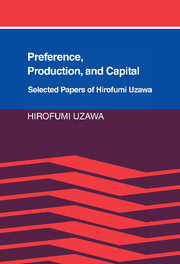Book contents
- Frontmatter
- Contents
- Foreword
- Preface
- I Preference and demand
- 1 Preference and rational choice in the theory of consumption
- 2 On the integrability of demand functions
- 3 Time preference, the consumption function, and optimum asset holdings
- II Duality and production
- III Concave programming
- IV Equilibrium and stability
- V Theory of economic growth
- VI Optimum growth
- Index
2 - On the integrability of demand functions
Published online by Cambridge University Press: 04 May 2010
- Frontmatter
- Contents
- Foreword
- Preface
- I Preference and demand
- 1 Preference and rational choice in the theory of consumption
- 2 On the integrability of demand functions
- 3 Time preference, the consumption function, and optimum asset holdings
- II Duality and production
- III Concave programming
- IV Equilibrium and stability
- V Theory of economic growth
- VI Optimum growth
- Index
Summary
Introduction
This paper deals with the properties of demand functions derived from utility maximization. Such properties may be either “finite” (involving finite sets of points) or “infinitesimal” (involving the derivatives of the demand functions). The “revealed preference” approach, pioneered by P. A. Samuelson and developed by H. S. Houthakker, is of the “finite” type. In what follows, we shall confine ourselves to the “infinitesimal” type of analysis, dealing with “substitution terms.” This analysis has been carried out in terms of the “direct” demand functions (quantities taken as functions of prices and incomes) by Slutsky, Hicks, Allen, Samuelson, and the “indirect” demand function (relative prices as functions of the quantities taken) by the “rediscovered” Antonelli, and also by Samuelson. The present paper deals only with the “direct” demand functions.
Perhaps the most familiar result, found in Hicks's Appendix in Value and Capital as well as in Samuelson's Foundations, is the fact that utility maximization (subject, of course, to the budget constraint) implies the symmetry and negative semidefiniteness of the Slutsky–Hicks substitution term matrix (derived from the “direct” demand functions). But much more remarkable is the converse proposition that, under certain regularity assumptions, if the demand function has a symmetric, negative semidefinite substitution term matrix, then it is generated by the maximization of a utility function.
In his Foundations of Economic Analysis, p. 116, Samuelson formulates the converse proposition and provides suggestions for a proof.
Information
- Type
- Chapter
- Information
- Preference, Production and CapitalSelected Papers of Hirofumi Uzawa, pp. 27 - 64Publisher: Cambridge University PressPrint publication year: 1989
